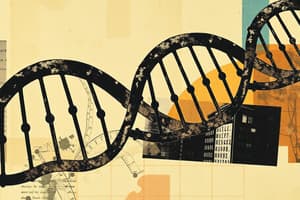Podcast
Questions and Answers
During DNA replication, what critical element is passed on to newly synthesized DNA strands to ensure the preservation of genetic information?
During DNA replication, what critical element is passed on to newly synthesized DNA strands to ensure the preservation of genetic information?
- The arrangement of sugars within the nucleotide backbone.
- The sequence of nitrogenous bases from the template DNA. (correct)
- The phosphate groups that link nucleotides together.
- The specific enzymes involved in unwinding the DNA helix.
Which process explains how all somatic cells in an organism can possess the same genetic information, despite having different functions?
Which process explains how all somatic cells in an organism can possess the same genetic information, despite having different functions?
- The modification of DNA through epigenetic mechanisms.
- The selective amplification of genes during cell differentiation.
- The accurate replication and distribution of DNA during cell division. (correct)
- The reassortment of chromosomes during mitosis.
If a template strand of DNA has the sequence ATCG, what would be the nucleotide sequence produced during DNA replication?
If a template strand of DNA has the sequence ATCG, what would be the nucleotide sequence produced during DNA replication?
- UAGC
- GCAT
- CGTA
- TAGC (correct)
Which property of DNA makes it particularly well-suited for replication?
Which property of DNA makes it particularly well-suited for replication?
What fundamental process is conserved across all living organisms in the synthesis of proteins?
What fundamental process is conserved across all living organisms in the synthesis of proteins?
A cell is unable to properly package and direct proteins to their correct destinations. Which organelle is most likely malfunctioning?
A cell is unable to properly package and direct proteins to their correct destinations. Which organelle is most likely malfunctioning?
Which of the following characteristics differentiates eukaryotic cells from prokaryotic cells at the structural level?
Which of the following characteristics differentiates eukaryotic cells from prokaryotic cells at the structural level?
A molecule within a cell membrane is described as having a polar 'head' and nonpolar 'tails'. Which type of molecule is being described?
A molecule within a cell membrane is described as having a polar 'head' and nonpolar 'tails'. Which type of molecule is being described?
Flashcards
DNA Information
DNA Information
The sequence of nitrogenous bases carries genetic information.
Cell Genetic Info
Cell Genetic Info
DNA replicates, creating two copies distributed into two cells.
DNA Replication Sequence
DNA Replication Sequence
TAGC
DNA's Suitability
DNA's Suitability
Signup and view all the flashcards
Protein Synthesis
Protein Synthesis
Signup and view all the flashcards
Protein Synthesis Steps
Protein Synthesis Steps
Signup and view all the flashcards
Golgi Apparatus Function
Golgi Apparatus Function
Signup and view all the flashcards
Eukaryotic Complexity
Eukaryotic Complexity
Signup and view all the flashcards
Study Notes
- Nucleic acid base sequences must be transmitted to new DNA strands during replication to maintain genetic information.
Body Cells
- Body cells contain the same genetic information through DNA replication, which creates two copies distributed into two cells.
DNA Replication
- If the template strand nucleotide sequence is ATCG, the produced nucleotide sequence during DNA replication would be TAGC.
- DNA's suitability as a molecule to make copies of itself is due to its two complimentary strands. When split, these strands can recreate the other through replication.
Protein Synthesis
- Protein synthesis universally involves transcription (DNA→mRNA) and translation (mRNA→Protein).
- Both prokaryotes and eukaryotes assemble proteins through transcription and translation.
Steps of Protein Synthesis
- Transcription occurs first.
- Translation occurs second.
Golgi Apparatus
- The Golgi apparatus packages proteins for distribution within or outside the cell.
- If the Golgi apparatus stopped functioning, many proteins would not be packaged or sent to the correct locations.
Cell Types
- Eukaryotic cells contain membrane-bound organelles.
- Both prokaryotes and eukaryotes contain genetic material.
- The cell is the simplest level of biological organization that can support life functions.
- Eukaryotes are considered more complex than prokaryotes because they contain membrane-bound organelles.
Molecules
- Lipids, specifically phospholipids, contain polar heads and nonpolar tails and are a component of plasma membranes.
- Nucleic acids consist of repeating units of sugar bonded to phosphate and a nitrogenous base and store genetic information.
Nucleic Acids
- "N.A." in DNA and RNA stands for Nucleic Acid.
- DNA stands for deoxyribonucleic acid.
- RNA stands for ribonucleic acid.
Proteins
- Amino Acids are the monomers of proteins.
- Proteins are long chains of amino acids folded into specific 3D structures that give them their function.
- Peptide bonds are the covalent bonds between amino acids in proteins.
Studying That Suits You
Use AI to generate personalized quizzes and flashcards to suit your learning preferences.




